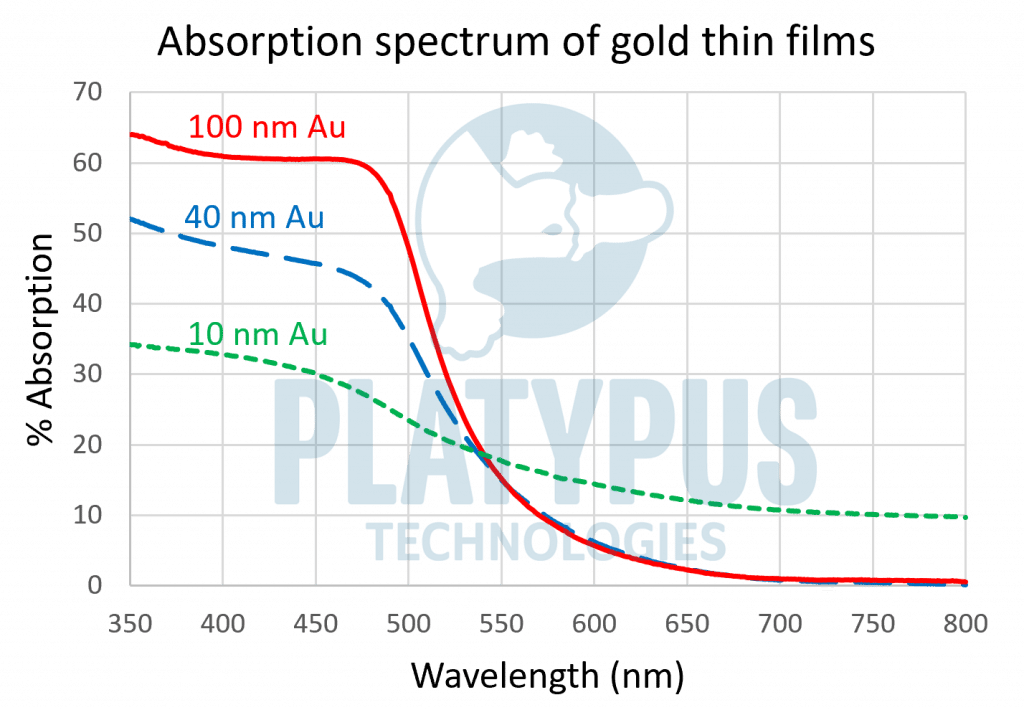Optical Absorption of Gold Thin Films
In the realm of material science and photonics, the optical properties of materials stand as a cornerstone of innovative applications. One such intriguing area of study is the optical absorption of gold thin films. As we venture deeper into nanotechnology’s advancements, understanding these properties becomes paramount.
Understanding Optical Absorption
Optical absorption refers to the process where a material captures photons from incoming light, converting them into other forms of energy, such as heat. It’s a pivotal property that intertwines with the material’s transmission and reflection capacities, essentially describing how it interacts with light.
Deriving Optical Absorption from Transmission and Reflection Spectra
The total light interacting with a material either gets transmitted (T), reflected (R), or absorbed (A). Mathematically, this is represented as follows:
A + T + R = 100%
We can measure the percentage of light transmitted (T) or reflected (R) from a material using an optical spectrometer. Then, for each wavelength, we can use the above equation to determine the percentage of light absorbed.
Thus, we can convert a given %transmission and %reflection spectral data into an optical absorption spectrum, providing a complete understanding of the light-material interaction for the sample in question.
In the discussion of optical absorption of gold thin films below, we calculated the absorption using the transmission and reflection spectra discussed in previous blogs.
Factors Influencing Optical Absorption in Gold Thin Films
In today’s tech-driven age, gold’s significance transcends beyond its aesthetic appeal, especially when reduced to films with nanoscale thickness. These gold thin films exhibit fascinating optical behaviors, much different from bulk gold.
The optical properties of gold thin films are heavily influenced by their thickness. As we transition from a 100 nm film down to a 10 nm film, these properties undergo noticeable changes. The figure below beautifully captures this variance in behavior.

The provided figure vividly showcases the optical absorption trends across three different thicknesses of gold films: 100 nm, 40 nm, and 10 nm.
- 100 nm Au film: This film exhibits a high absorption rate at optical wavelengths between 350 and 500 nm. At longer wavelengths, however, the optical absorption falls rapidly to zero.
- 40 nm Au film: A moderate absorption curve with some distinct characteristics compared to the thicker counterpart. At wavelengths between 350 and 500 nm, this film exhibits lower absorption compared to the 100 nm Au film. However, at longer wavelengths the absorption curve of this film is identical to the absorption curve for a thicker film.
- 10 nm Au film: This thinnest film showcases a unique trend, where absorption is significantly lower at short wavelengths. However, at long wavelengths (>480 nm) this film exhibits higher absorption than the films with 40 nm or 100 nm of gold.
The ability to modulate gold’s optical properties by varying its thickness paves the way for a multitude of applications. Enhanced sensors, innovative imaging techniques, and advanced photonics components are just the tip of the iceberg. By leveraging the unique absorption profiles of these films, we can design cutting-edge devices tailored for specific optical needs.
Conclusion
Gold thin films, with their intriguing optical absorption characteristics, are at the forefront of research in nanotechnology and photonics. A comprehensive understanding of these films, combined with the knowledge of deriving absorption from transmission and reflection spectra, will be instrumental in driving further innovations in the field.
If you found this analysis enlightening, consider sharing it with your network. Dive deeper into the world of photonics and nanotechnology by exploring related articles and breakthrough research in the domain.